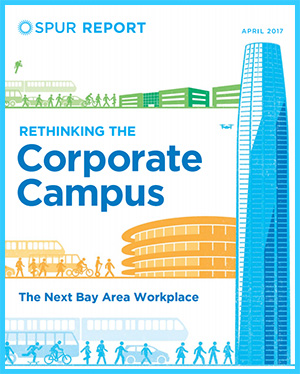
A recent web post from HOK examines the future of the sprawling suburban corporate campus. Here is the story:
“Since their debut in the 1950s, suburban corporate campuses have come to symbolize the culture and success of U.S. enterprise. But could the era of the suburban corporate campus be nearing its end?
Moreover, given the impact these workplaces can have on both the environment and employee satisfaction, should it be nearing its end?
Those are the central questions put forth in Rethinking the Corporate Campus, a white paper published by the San Francisco Bay Area think tank SPUR. The report looks specifically at the influence suburban campuses have had on Silicon Valley, though insights gleaned from the paper could apply to companies seeking a new corporate headquarters elsewhere.
In creating “Rethinking the Corporate Campus,” SPUR solicited input from a 21-person task force of industry experts that included three urban planners with HOK’s San Francisco office: Steve Morton, regional director of planning + consulting; Rae Smith, senior urban designer; and Brian Jencek, director of planning.
Suburban corporate offices, with their large, single-level floor plates, have been instrumental in fostering the type of innovation and collaboration for which Silicon Valley is known. Yet these sprawling campuses—born in an era of cheap land and intended to be easily expanded or disposed of to accommodate Silicon Valley’s booms and busts—are no longer the automatic choice.
The spread of suburban campuses has not only contributed to regional “job sprawl” (the Bay Area has the nation’s second highest total delay and commuter stress), but they’ve also made it more expensive and difficult to recruit and retain talent. Many Bay Area employers in the suburbs are now expected to provide shuttle service and other costly perks to attract and keep employees.
On the flip side, several well-known Silicon Valley brands (Salesforce, LinkedIn, Twitter and Airbnb) recently have bucked the suburban-campus trend and done the “once unthinkable” for tech giants. They’ve moved their headquarters into vertical downtown offices or converted industrial buildings centrally located near public transit. Unlike suburban campuses that reinforce an insular and secretive workplace culture, these more accessible urban campuses support the principles of agglomeration, the theory that innovation occurs faster in dense environments in which workers, suppliers, funders and partners are co-located for collaboration.
At the same time, renovated suburban corporate campuses, such as the Central & Wolfe Campus in Sunnyvale, can offer what the SPUR report describes as a “hybrid” approach in adopting aspects of both vertical and traditional campuses.
SPUR’s research found Silicon Valley tech firms consider the following four factors most often when choosing a new workplace:
- Talent Acquisition and Retention:How close is the campus to its employees and what financial and environmental costs come with getting employees to that location?
- Security/Intellectual Property:How open can the campus be in both its interior layout and its public-facing exterior?
- Floor Plates: Is a large, flexible floor plate necessary for collaboration? Or would different departments function better on separate floors or workspaces?
- Growth and Exit Strategy:How easy would it be to increase the workspace during good times or, conversely, scale it down when necessary?
Download the full SPUR report.”
Here is a link to the original HOK article.

